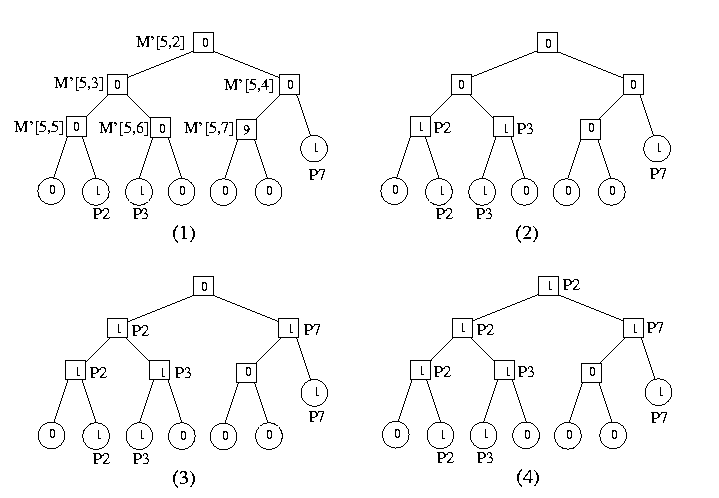
| Back to the beginning of the page | Back to the CS838 class schedule |
| The PRAM corresponds intuitively to the programmers' view of a parallel computer: it ignores lower level architectural constraints, and details, such as memory access contention and overhead, synchronization overhead, interconnection network throughput, connectivity, speed limits and link bandwidths, etc. |
| Back to the beginning of the page | Back to the CS838 class schedule |
T(n,p)=log p + n/p
T(n,p)=log p + n/p
T(n,p)=n/p.
| Back to the beginning of the page | Back to the CS838 class schedule |
PRIORITY >= ARBITRARY >= COMMON >= CREW >= EREW
| Back to the beginning of the page | Back to the CS838 class schedule |
Proof:
Proof:
| Back to the beginning of the page | Back to the CS838 class schedule |
Proof:(Constructive.)

Proof:(Constructive.)
f=0, if the first component of A[k] is either 0
or it is the same as the first component of A[k-1]
f=1 otherwise.
| P1 wants to access M[2], |
| P2 wants to access M[4], |
| P3 wants to access M[2], |
| P4 wants to access M[1], |
| P5 wants to access M[4], |
| P6 wants to access M[2], |
| P7 wants to access no cell at all. |
| (2,1, ) | (4,2, ) | (2,3, ) | (1,4, ) | (4,5, ) | (2,6, ) | (0,7, ) |
| (0,7, ) | (1,4, ) | (2,1, ) | (2,3, ) | (2,6, ) | (4,2, ) | (4,5, ) |
| (0,7,0) | (1,4,1) | (2,1,1) | (2,3,0) | (2,6,0) | (4,2,1) | (4,5,0) |
| (2,1,1) | (4,2,1) | (2,3,0) | (1,4,1) | (4,5,0) | (2,6,0) | (0,7,0) |
| (0,7,0) | (1,4,v1) | (2,1,v2) | (2,3,0) | (2,6,0) | (4,2,v4) | (4,5,0) |
| (0,7,0) | (1,4,v1) | (2,1,v2) | (2,3,v2) | (2,6,0) | (4,2,v4) | (4,5,v4) |
| (0,7,0) | (1,4,v1) | (2,1,v2) | (2,3,v2) | (2,6,v2) | (4,2,v4) | (4,5,v4) |
| (2,1,v2) | (4,2,v4) | (2,3,v2) | (1,4,v1) | (4,5,v4) | (2,6,v2) | (0,7,0) |
| Back to the beginning of the page | Back to the CS838 class schedule |
| Any polylog-time PRAM algorithm is robust with respect to PRAM models. |
| Back to the beginning of the page | Back to the CS838 class schedule |